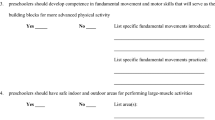Abstract
The home is where young children spend most of their time. Whether it is the home of the day care provider or their own home, it is the place where much of their learning takes place during their early years. Providers and parents can arrange the home environment to maximize learning for infants, toddlers, preschoolers, and school-agers. Setting up activity centers is a good way to organize space, ensure optimum learning opportunities, and facilitate supervision.
Similar content being viewed by others
References
Bredekamp, S. (Ed.). (1987).Developmentally appropriate practice in early childhood programs serving children from birth through age 8. Washington, DC: National Association for the Education of Young Children.
Broman, B. L. (1989).The early years in childhood education. Boston: Houghton Mifflin.
Greenman, J. (1988).Caring spaces, learning places: Children's environments that work. Redmond, WA: Exchange Press.
Houle, G. B. (1987).Learning centers for young children. West Greenwich, RI: Consortium Publishing.
Katz, L., & Chard, S. (1989).Engaging the minds of young children: The project approach. Norwood, NJ: Ablex.
Meyers, B. K., & Maurer, K. (1987). Teaching with less talking: Learning centers in the kindergarten.Young Children, 42(5), 20–27.
Phillips, J. L. (1975)The origins of intellect: Piaget's theory (2nd ed.). San Francisco: W. H. Freeman.
Piaget, J. (1952).The origins of intelligence in children. New York: Norton.
Piaget, J. (1954).The construction of reality in the child. New York: Basic Books.
Sigel, I. E., & Cocking, R. R. (1977).Cognitive development from childhood to adolescence: A constructivist perspective. New York: Holt, Rinehart, & Winston.
Wolfgang, C. H., & Wolfgang, M. E. (1992).School for young children: Developmentally appropriate practices. Boston: Allyn & Bacon.
Additional information
Jean Billman is Professor of Early Childhood Education at Winona State University in Minnesota. She has been a center director and now directs a laboratory preschool on campus.
Rights and permissions
About this article
Cite this article
Billman, J. Activity centers in the home: Ideas for family day care providers and parents. Early Childhood Educ J 20, 25–29 (1992). https://doi.org/10.1007/BF01617677
Issue Date:
DOI: https://doi.org/10.1007/BF01617677




